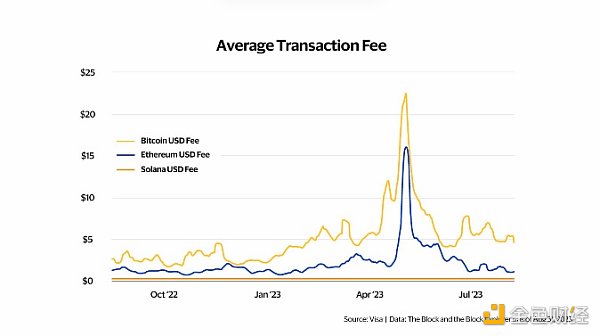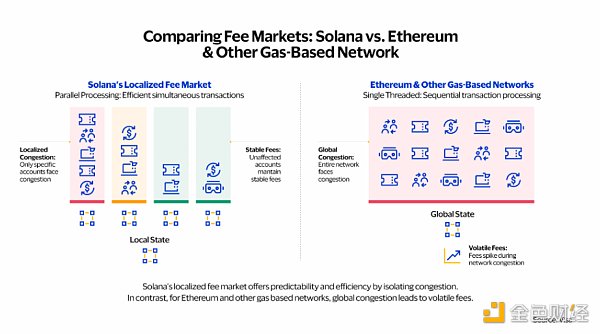Author: Mustafa Bedawala, Visa Crypto Product Manager; Arjuna Wijeyekoon, Visa Crypto Fintech Vice President; Translation: LianGuai0xjs
For a long time, there have been proposals about blockchain networks as a new innovative payment avenue. However, over the years, blockchain networks have struggled to scale in order to support the high throughput, low-cost secure transactions that payment companies need and consumers expect. In the past year, the Visa team has been closely following the technological innovations behind blockchain scalability and is excited about the significant progress made with new L2 networks on Ethereum and the creation of blockchain alternative networks from scratch. Our goal is to deeply understand the technical characteristics of blockchain networks and explore how to leverage these characteristics to enhance our existing network and create new products for business and fund flows.
While we believe that the payment ecosystem may use multiple blockchain networks, we consider Solana blockchain network as having the potential to become one of the networks that help drive mainstream payment flows. With its speed, scalability, and low transaction costs, Solana has a significant advantage in payments, making it an excellent candidate for efficient blockchain settlement using stablecoins such as USDC. Solana blockchain network has many key features and novel innovations that are worth exploring for anyone interested in payment technology.
1. Visa-scale transaction throughput
- Coin Metrics Ethereum Merger One-Year Review
- Full Name Categorization of On-chain Identity Layer
- What potential impacts will the launch of MetaMask Snaps open beta bring?
As a global payment network, Visa can process over 65,000 transactions per second. While Solana has not yet processed transactions at the scale of Visa, Solana averages 400 transactions per second (TPS) generated by users, which can spike to over 2,000 TPS during peak demand. This is a significant level of throughput that makes it suitable for testing and piloting payment use cases. In comparison, Ethereum averages 12 TPS and Bitcoin processes around 7 TPS.
Parallel transaction processing: With its high transaction throughput design, Solana can process transactions in parallel, greatly improving network efficiency. Transactions that affect separate accounts can be executed simultaneously, allowing Solana to effectively support payment and settlement scenarios with two-party transactions or one-way multi-party payments.
In Solana, smart contracts called programs can also be executed in parallel. Transactions specify the state or account they interact with, allowing validators to run conflicting transactions concurrently. Unlike other chains like Ethereum that use a single-threaded model, Solana employs a multi-threaded approach for parallel transaction execution. In short, while blockchain networks like Bitcoin and Ethereum process transactions sequentially, Solana’s architecture allows for concurrent processing of multiple transactions. This design helps prevent congestion in one part of the network from affecting overall network performance.
2. Predictable low transaction costs for improved payment efficiency
In terms of cost, Solana’s transaction fees are typically below $0.001, making it not only affordable but also predictable. This combination of low cost and predictability makes it an attractive network for exploring efficiency improvements and cost savings in existing payment businesses. In the comparison below, Solana clearly outperforms Bitcoin and Ethereum in terms of cost, as the fees for Bitcoin and Ethereum can fluctuate unpredictably based on transaction demand on the network. A network with unpredictable transaction costs can make it more challenging for payment companies to manage their products and may lead to confusing consumer experiences.

Ensuring Cost Predictability through Localized Fee Market: Solana’s localized fee market is unique in the blockchain space. This innovation is closely tied to Solana’s parallel processing capabilities, where non-overlapping transactions are executed in separate threads, much like vehicles driving on separate roads. Network congestion is a significant reason why other blockchain networks may experience fee hikes, which can have negative implications for the entire system. The popularity of NFT releases may contribute to network congestion, making P2P transactions (potentially happening simultaneously) more expensive, even economically unviable.

Solana’s approach helps ensure that congestion in one account (e.g., Alice’s USDC balance) does not affect other accounts (e.g., Bob’s USDC balance). If an account becomes busy due to high demand for a specific asset (such as NFTs), only the fee for that specific account will increase. The fees for other accounts will remain unaffected and stable. This results in a fee market responsive to demand. When demand for a specific asset surges, the transaction cost for that asset temporarily rises. Meanwhile, the cost of other on-chain transactions remains unaffected. By allowing parallel execution of computations with different states, Solana can create a fee market based on “state competition” rather than having a single global fee market.
3. Consumer Expectation of Transaction Finality
Transaction finality measures the speed at which users can expect their operations to be confirmed on the blockchain network. For payments, transaction confirmation time is equally important as network throughput. For example, Ethereum has an average transaction confirmation time of around 12 TPS; however, due to gas limitations during network congestion and requirements of smart contracts, users may experience several minutes of waiting time before their transactions are confirmed. Solana aims for a slot time of 400 milliseconds, with an actual achievable range between 500 to 600 milliseconds.
The majority of applications in Solana use an “optimistic confirmation” model to achieve transaction finality. Optimistic confirmation is a mechanism employed by the Solana blockchain that achieves finality without waiting for all validators (or entities responsible for block generation) to vote on a block. In the optimistic confirmation model, if more than two-thirds of validators representing delegated stake vote for a block, and the block passes optimistic confirmation without any rollbacks or failures, then the block is considered finally confirmed. This mechanism allows Solana to achieve finality in a shorter time compared to many other blockchains. Faster transaction completion speed can lead to a better payment experience. In contrast, Bitcoin may require an additional creation of six blocks, taking up to 60 minutes, before a transaction is considered securely final.

4. Availability: Large Number of Nodes and Multiple Validator Clients
Only when users need to make payments, the payment network can be initiated and transactions can be executed, making the payment network effective. For a blockchain network, availability is best measured by the number of independent participants or nodes that can initiate transactions through the collectively operated network. As of July 2023, the Solana network has 1893 active validators (entities responsible for generating and voting on blocks), which is an impressive number. In addition, there are 925 nodes called RPC nodes, which may not create blocks themselves but maintain local records of transactions. The large number of nodes in the blockchain network enhances its resilience and redundancy. If some nodes encounter issues or go offline, as long as a sufficient number of nodes remain operational, the network can still function properly without losing data. The Solana community also pays attention to the geographic locations of nodes and the diversity of infrastructure providers to make the network more robust in handling events such as natural disasters or changes in access policies by providers. Solana network nodes are distributed across more than 40 countries with hundreds of unique hosting arrangements and locations. This helps ensure that the network can operate smoothly and reliably even in the face of technical challenges.
A validator client is a software tool that allows node operators to act as validators on a proof-of-stake blockchain. The diversity of validator clients enhances network resilience. While one client may have errors or vulnerabilities, another client may not. This ultimately reduces the possibility of network paralysis due to a single software issue. The validator client initially used by Solana was from Solana Labs. In August 2022, Jito Labs launched the second validator client jto-Solana for the mainnet. Shortly after, Jump Crypto introduced Firedancer (in the testing phase), an independent C++ validator client. Firedancer stood out for its potential to bring substantial performance enhancements, achieving a live demonstration of 600,000 TPS. The purpose of having different validator clients is to maintain the stable operation of the network. Apart from Ethereum, Solana is one of the few chains with multiple completely independent validator clients.
5. Meeting Modern Needs
Solana’s unique technological advantages, including high throughput through parallel transaction processing, low-cost localized fee markets, and high scalability with numerous nodes and multi-node clients, create a scalable blockchain platform with an impressive value proposition for payments. This is one of the reasons why we decided to expand the stablecoin settlement pilot to include transactions on the Solana network. While testing our stablecoin settlement functionality on Solana, we also plan to evaluate Solana’s ability to meet the needs of modern enterprise financial operations.
Like what you're reading? Subscribe to our top stories.
We will continue to update Gambling Chain; if you have any questions or suggestions, please contact us!